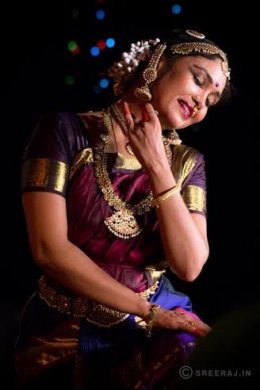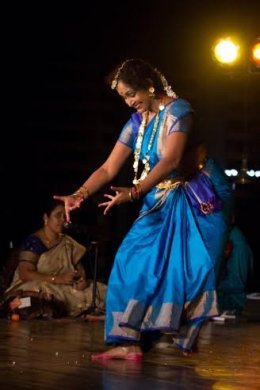
|   |

|   |
Mudra Dance Festival 2016: Day 2 - Shereen Saif e-mail: shereen.saif@gmail.com Photos: Sree Raj January 23, 2016 The 12th edition of the annual five-day Mudra national dance festival got off to a tinkling start on 6th January. Considered a must-attend by connoisseurs, the fete was as always a showcase of various Indian classical dance forms, packed with workshops and lectures during the day and performances during the evening. I managed to catch the evening show of Day 2, a 2-part spectacle beginning with a Bharatanatyam recital by Dr. Rajashree Warrier and capped off with Dr. Yashoda Thakoreís presentation of Courtesan dance. Poetic beauty The koothambalam at Vyloppilli Samskrithi Bhavan, Thiruvananthapuram, was packed and abuzz with anticipation on the dot of the appointed hour. Multi-faceted Bharatanatyam exponent, Keralaís own Dr. Rajashree Warrier was making a comeback to the festival after a 7-year break and her die-hards certainly didnít want to miss it.  Dr. Rajashree
Warrier
As soon as her accompanists had warmed up the stage with a Ganesha vandanam, Warrier took her cue for a graceful entry. She opened with haloed verses from Ramalinga Vallalarís poem, seeking the company of the noble and fervently wishing for non-association with those whose speech contradicted their thoughts.This dovetailed smoothly into Maharaja Swati Thirunalís composition Bhogindra Sayinam in Kuntalavarali, Khanda chaapu talam. In this classic, the dancer offered obeisance to Lord Padmanabha, the immortal one who reclines on Adishesha, the thousand-headed serpent king. The choreography by Warrier was sprightly, punctuated by brief moments of stillness each time she struck the reclining pose after executing a signature dance phrase. For her second piece, Warrier picked Aaadum azhagai, a ragamalika composition by Gopalakrishna Bharati where the awestruck nayika describes to her sakhi the resplendent beauty of Shiva as he dances in bliss. The centerpiece of her recital was Ashtapatni, her own creation inspired by legends from the Srimad Bhagavatam describing how Krishna came to marry his 8 principal consorts. From Rukmini to Satyabhama, Jambavati, Kalindi, Mitravinda, Nagnajiti, Bhadra and Lakshmana, she strung a series of tales filled with adventure, enchantment and passion. The dancer went on to say that although Krishna had the company of multiple wives, his heart always yearned for something else. And what that was, was revealed in the climax of the piece. In his dreams, Krishna is transported to a time and place of innocence, mirth, boundless love and cherished moments. Radha was his eternal lover and his heart would yearn for her as long as he lived. With supporting Malayalam lyrics from Sugathakumariís poem, Warrier concluded with a sensitive and poignant portrayal of the star-crossed lovers. With that last segment infused with beauty and tenderness, the dancer in her imitable style created an indelible expression in the minds of the audience. Her accompanists Neelamperur Suresh Kumar (nattuvangam), Sreedev Rajagopal (vocal), Payyanur Rajan (mridangam), Sreekumar (violin), V. Soundarajan (veena) and Srikumar (flute) lent excellent support to uplift the performance. Keeping alive Andraís courtesan dance tradition Kuchipudi and Vilasini Natyam exponent Dr. YashodaThakore led the second half of the show by offering a glimpse of courtesan dance practiced by the kalavanthulu of coastal Andra Pradesh. This was the first time in the history of Mudra Festival that courtesan dance was being included as part of the showcase and it had piqued the curiosity of many.  Dr. YashodaThakore
The presentation took on the guise of a lecture demonstration as Thakore wove in the historical context and elaborated on the Mezuvani (salon or court) tradition of the dance form. Following a vocal rendition in praise of the presiding deity at Ballipadu, Thakore demonstrated a Salaam Daru native to the Godavari region. The first two verses of the composition was a salutation to Pratapa Simha, a patron and 18th century Maratha king of Tanjavur while the 3rd verse addressed Serfoji II. Next in line was a pure nritta piece, a Swara pallavi in Arabhi with simple movements and hastas, exuding rudimentary charm. Thakore explained that the Varnam in the Mezuvani repertoire is executed as a seated abhinaya piece rather than a dance composition. For the recital, she chose an age-old varnam in Kamas where the pining nayika implores her sakhi to fetch Lord Brihadeeshwara. Demonstrating only the purvanga (first half) of the varnam, the dancer concluded with a nakhashikha varnana of the sakhi. After warning the audience that upcoming content could be of a blasphemous nature, the dancer plunged into a composition where a Samanya nayika (courtesan) refuses a customer because she does not consider him good enough. She teases that he will have to pay a bag of gold for every word she speaks and when the young man starts to weep, she chides him and ultimately asks him to leave because it was time to receive her Lord Parthasaarathy! Delivered seated, this piece like the varnam, freely used rati (lovemaking) hastas, giving one an impression that the kalavanthulus of yore were confident in their own sexuality without appearing vulgar. The presentation concluded with a Javali where a Parakiya nayika bares her heart to Krishna that she cannot live without him but is forced to leave because her mother-in-law beckons! The piece ended in a flourish with a gaptuvarisai, an impromptu string of pure dance movements. Supported by C.S Shanti on vocal and nattuvangam, Radhakrishnan on the violin and Sridharacharya on the mridangam, the presentation was rather unusual and offered insight into the social and artistic world of the courtesans of Andra Pradesh. Shereen Saif is a dancer, theatre professional, creative movement advocate and PR consultant based in Dubai. She is a Mohiniattam disciple of Dr. Neena Prasad and pursues her training in traditional theatre techniques under veteran Kuttiyattam exponent Venu G. |